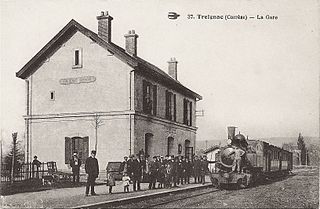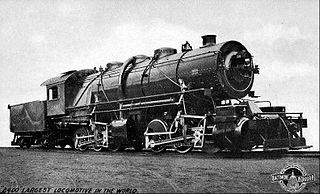Under the Whyte notation for the classification of steam locomotives, 2-8-2 represents the wheel arrangement of two leading wheels on one axle, usually in a leading truck, eight powered and coupled driving wheels on four axles and two trailing wheels on one axle, usually in a trailing truck. This configuration of steam locomotive is most often referred to as a Mikado, frequently shortened to Mike.

Établissements Billard was a French railway rolling stock construction company based in Tours. It specialised in light railbuses and metre gauge and narrow gauge rolling stock. The business ceased trading in 1956 and later became Socofer.

Chemins de Fer de la Corse (CFC) is the name of the regional rail network serving the French island of Corsica. It is centred on the town of Ponte-Leccia, from which three main lines radiate to Ajaccio, Bastia, and Calvi. The section following the northwest coastline between L'Île-Rousse and Calvi, known as the Balagne line, gives access to many beaches and is very popular with tourists.

The Compagnie du chemin de fer de Caen à la mer (CM) was an early French railway company.

État 42-001 to 42-020, was a class of 2-8-2 Tank locomotives of the Chemins de Fer de l'État.

État 140-101 to 140-370 is a class of 2-8-0 steam locomotive of the Chemin de fer de l'État, and subsequently the Société Nationale des Chemins de fer Français (SNCF).

The Chemin de Fer de la Baie de Somme, is a preserved railway in northern France. The railway is managed by a non-profit organization, which runs from March to December between the towns of the Baie de Somme area: Le Crotoy and Cayeux-sur-Mer via Noyelles-sur-Mer and Saint-Valery-sur-Somme, on metre gauge tracks. The association was founded in 1970 and over the years it has become a major player in tourism development in the Picardy coast and is also responsible for the preservation, safeguarding and enhancement of the fleet full of cars, wagons, steam locomotives and diesel locomotives. The line is one of the closest French heritage lines to the UK, Noyelles is 73 kilometres (45 mi) from Boulogne-sur-Mer and 105 kilometres (65 mi) from Calais. A part of the line has dual gauge track, and although forming part of a group of five lines, at least a part of it has always been open to traffic.

The Baldwin Class 10-12-D was a class of narrow gauge 4-6-0 pannier tank steam locomotives built by the Baldwin Locomotive Works (USA) for the British War Department Light Railways for service in France during World War I. They were built in 1916-1917 to 600 mm gauge.

The Froissy Dompierre Light Railway (CFCD) is a 600 mm narrow gauge light railway running from Froissy to Dompierre-Becquincourt, through Cappy, in the Somme department, France. It is run as a heritage railway by APPEVA and is also known as P'tit Train de la Haute Somme. It is the last survivor of the 600 mm narrow gauge trench railways of the World War I battlefields.
The Réseau Albert was a set of railway lines in France from 1889–1955, part of the Chemins de fer départementaux de la Somme. There were four lines in the Réseau Albert system:- Albert - Doullens, Albert - Ham, Fricourt - Montdidier and Offoy - Ercheu. All lines were built to 1,000 mm, metre gauge. The entire system extended to 190 kilometres (120 mi).

Corpet-Louvet was a steam locomotive manufacturer based in Paris, France.
The Chemin de Fer du Cambrésis was a 120-kilometre (75 mi) long metre gauge railway in the Nord and Aisne departments of France. There were four lines with Caudry at the centre.

The Chemins de fer départementaux du Finistère (CFDF) was a metre gauge railway system in northwest Brittany, France. It was opened in stages between 1893 and 1907, and closed in 1946. The system had a total extent of 214 kilometres (133 mi).

The Chemin de fer des Côtes-du-Nord, the Côtes-d'Armor today, was a 1,000 mm, metre gauge, railway in Côtes-du-Nord, France, although there were a few kilometres of line in Finistère and Ille-et-Vilaine. The first lines opened in 1905 and final closure was in 1956. The lines were a voie ferrée d'intérêt local system with a total extent of 457 kilometres (284 mi).
The Tramway de Pithiviers à Toury (TPT) was a 600 mm narrow gauge railway in the Loiret department of France. The system had a total extent of 80 kilometres (50 mi)
The Chemin de Fer du Blanc-Argent (BA) is a 1,000 mm gauge railway in the Centre-Val de Loire region of France, part of which is still open to traffic, whilst another section is now operated as a heritage railway.

The PO Corrèze (POC) is a former metre-gauge railway in the Corrèze department in central France. The concession was granted to the Chemin de Fer de Paris à Orléans (PO) and constructed by the Société de Construction des Batignolles. Together with the Chemin de Fer du Blanc-Argent and the Blois à Saint Aignan, they formed the metre-gauge network of the PO.
The French National Railways used to run a considerable number of 1,000 mmmetre gauge lines, a few of which still operate mostly in tourist areas, such as the St Gervais-Vallorcine (Alps) and the "Train jaune" in the Pyrenees. The original French scheme was that every sous-prefecture should be rail connected. Extensive 600 mm gauge lines were also built for the sugar-beet industry in the north often using ex-military equipment after the First World War. Decauville was a famous French manufacturer of industrial narrow-gauge railway equipment and equipped one of the most extensive regional 600 mm narrow-gauge railway, the Chemins de Fer du Calvados. Corsica has a narrow-gauge network of two lines following the coast line, that are connected by one line crossing the island through highly mountainous terrain. The petit train d'Artouste, a tourist line in the Pyrenees, uses 500 mm gauge.

The Kivu Railway was a 94 km (58 mi) long narrow gauge railway with a gauge of 3 ft 6 in from Kalundu to Kamaniola in the Congo, which operated from 1931 to 1958.




















